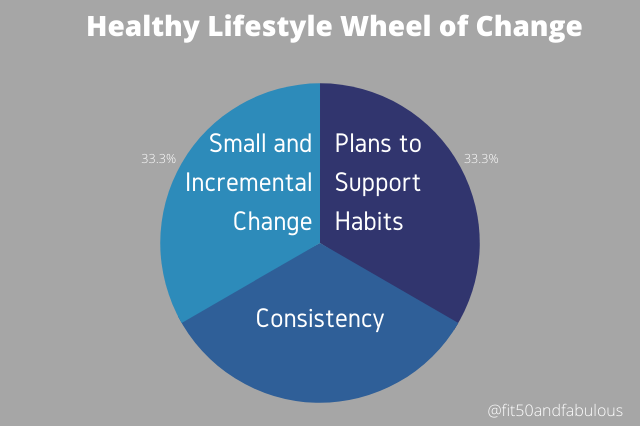I know I talk a lot about eating right, maintaining a healthy weight, and exercising to create a healthy lifestyle. That’s because I believe that all of these things can improve our longevity and independence no matter what our age. To me, these efforts translate to not having to take handfuls of very expensive medication every day and being able to complete life’s daily tasks without assistance. And let’s face it, when we creep into our 50s, both can become a reality.
Yes, you may be genetically predisposed to some ailments or conditions where you cannot thrive or even live without medication, thereby impacting your longevity. And you might have incurred an injury or trauma in your early years, which has reduced the ability to perform some daily function, thus impacting your independence over time.
But I also believe that even in your 50s and beyond, there is always an opportunity to seize control over any of these three elements (eating right, maintaining weight, and exercising) in some small way, shape, or fashion, and make small, incremental improvements that move us towards a healthy lifestyle.
In this article, I will show you how to re-imagine yourself so you can create a healthy lifestyle.
The Healthy Lifestyle Wheel of Change
Three basic elements support making sustainable changes that equate to a healthy lifestyle. Just like a 3-legged stool, you cannot have anyone without the other. Each is dependent on one another to achieve long-lasting success.
What’s better, is that they are not hard to implement at all.

Small and incremental changes
Eating right doesn’t mean a crash diet that changes everything about your life. It does mean eating smaller portions, reducing your sugar intake, increasing your consumption of fruits and vegetables, drinking more water, and decreasing the amount of processed food you eat.
For exercise, it certainly doesn’t mean joining a gym or signing up for the latest Beachbody craze. Instead, it means making small, incremental changes and simply moving more. Park further away from a store entrance. Take the stairs instead of the elevator. Take a short walk after lunch or after dinner.
Regardless of the improvements or changes you want to make, you can build a healthy lifestyle, start small, and take gradual steps towards incorporating one thing. Yes, it’s another way of saying small and incremental. Why is this a big deal?
Change is hard. We are creatures of habit, and the older we get, the harder it is to unravel years of ingrained habits. But not impossible. It just takes a more deliberate and thoughtful approach. To build successful habits that support healthy lifestyle change, we must also consider what systems need to be put in place to support the successful execution of those changes. This is critical and not be overlooked.
A plan to support new healthy lifestyle habits
Why is a plan a critical for healthy lifestyle change? I’ll give you an example.
You decide you’re we’re going walk for 10 minutes after dinner. You start like gangbusters, and for a period of 10 days, are consistent about getting in a walk every day. Then one day, it rains. Or you go out for dinner and get home late. Or you have a headache. Soon the urgency to walk after dinner fades. After a while, you stop doing it altogether. Is your quest for a healthy lifestyle doomed to fail?
No. This change didn’t fail because you weren’t motivated or because you’re lazy. It’s because you hadn’t developed a plan to support the plan to walk for 10 minutes after dinner.
So, what was missing?
First, the plan was vague. You’re going to walk for 10 minutes after dinner. Where? When? What’s the contingency for inclement weather? How will you adjust for unexpected changes? Who did you message your intention to so you could be supported?
Now let’s take the same scenario, this time with plan in place.
“I’m going to walk for 10 minutes after dinner, 4-days a week, Monday through Thursday, around my neighborhood. If rain is forecasted on any of those days, I will walk inside at the nearby mall or follow a walk-in-place video on YouTube. I will tell my family of my plan so they can deconflict their schedule with mine. If something unexpected pops up and I cannot walk on a designated day, I will add a day to the schedule.”
With a more concrete plan established, you increase your chances of success and ultimately develop a new habit to build your healthy lifestyle. If we wing it by just saying, “I’m going to walk after dinner every day,” we leave too much room for ambiguity, and as creatures of habit, anything that has the potential to sway our intentions will do just that. It’ll be harder to get back on track.
Consistency is a key ingredient

In addition to making small and incremental changes supported by a plan to optimize success, any change has to be consistently executed to fulfill the goal of building a healthy lifestyle.
Eating one apple instead of a cinnamon apple muffin just once won’t set you firmly on the path to a healthier you. Neither will taking just one walk. Any change you implement has to be done consistently.
Think of it this way. Saving $50 out of 1 paycheck just once won’t provide enough money for a down payment on the shiny new whatchamathing. Saving $50 out of every paycheck for a year will yield $1,300 or $2,600 (if you get paid bi-weekly or weekly), enough for a down payment on your shiny whatchamathing or to purchase it outright.
Like saving money, any change you make has to be executed consistently to add up to meaningful results over time. It doesn’t happen overnight. That’s how a healthy lifestyle is built.
Become the change you seek
The good news is since you’ve already established a plan to support whatever change you made, you’ve laid the groundwork towards building the needed consistency to develop healthy lifestyle habits.
Now, here’s the bad news. Plans are great, but plans alone won’t deliver the consistency you need to achieve the desired change and make it last. The change needs to be part of your identity. It needs to become part of YOU.
In the example of walking after dinner, it’s not a task you want to complete – it’s the person you want to become. You want to become a person who walks after dinner every day.
Once we wrap our identity around a habit or goal, it becomes part of us and part of what we do every day, just like brushing our teeth. Those activities become consistent because it’s who we want to become.
I’ll give you a perfect example of this: me.
I identity myself as a fit person. I have developed a plan to support my desire to exercise consistently. Every morning, I get up and weight train, walk or do yoga as part of my regular exercise routine. I prepare by setting my clothes out the night before and have a particular workout routine that I follow depending on the day of the week. I always take the stairs, and I look for ways to incorporate more activity and movement into my daily activities and vacation. It’s part of my identity and part of who I’ve become. I am a person who exercises every day.
Say you want to cut down on drinking. Someone offers you a beer. Instead of saying “No, I’m trying to cut down,” say “No, I don’t drink.” One represents who you are; the other represents who you want to be. By consistently identifying with who you want to be, a subtle shift in our brain begins to occur. For the person offering you the beer, it also signals to them not to ask you, “Are you sure?” because you’ve already told them you’re not a drinker.
Putting it into practice
First off, don’t underestimate your capacity to re-imagine yourself and lead a healthy lifestyle. The fact that you’ve read this far suggests that you have a desire to be healthier!
Let’s see an example of how we combine a small change with a plan and incorporate it into our identity, so we become that person.
If your goal is cut back on dessert, be specific. Don’t just say “I will cut back on dessert”. Instead, try this:
“I will only eat dessert once a week”.
Now make a plan.
“Thursday will be the only day that I eat dessert. I will take one serving and sit at the kitchen/dining room table. I will eliminate distractions and only focus on eating the dessert. When I am finished, I will wash my plate and fork and put them away. I will tell my family and friends of my plan, so they don’t plan for dessert any other day but Thursday. If I cannot have my dessert on Thursday, I will plan to have it by Saturday. This is what a healthy person does to live a healthy lifestyle, and I am a healthy person.”
Executed consistently, you become a person who only eats dessert occasionally. In fact, the science of neurochemistry suggests that thoughts and beliefs repeated over time are what change our habits. In time, you may not want dessert at all.
This is only an example, but hopefully, you get the idea. If you’re stuck figuring out how to start, ask yourself – “What would a healthy person do?”, “What would a fit person do” or better yet, “Who do I want to be?”.
Final Words
I would love for everyone to recognize that creating a healthy lifestyle is absolutely achievable, especially if you’re in your 50s or older. Even if you have physical and medical limitations, making the smallest changes can yield incredible results over time.
What we’ve lacked all along were the simple tools to help us get started. Now that you have the tools, I encourage you to take control of your mobility and independence and set yourself on the path of living a Fit and Fabulous life!

